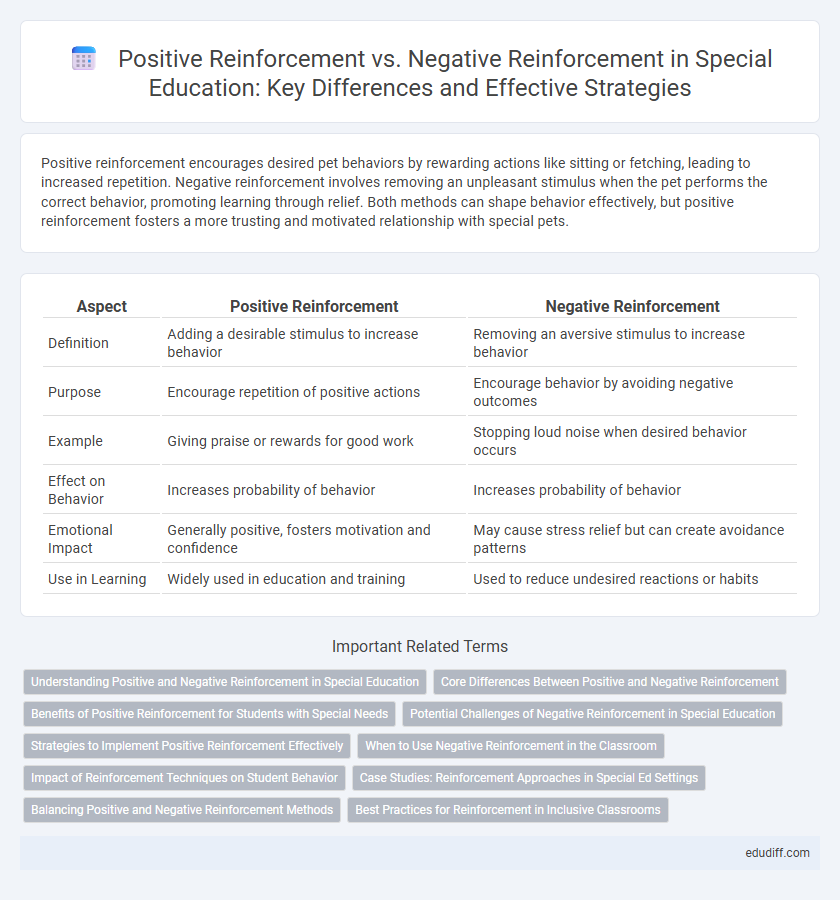Positive reinforcement encourages desired pet behaviors by rewarding actions like sitting or fetching, leading to increased repetition. Negative reinforcement involves removing an unpleasant stimulus when the pet performs the correct behavior, promoting learning through relief. Both methods can shape behavior effectively, but positive reinforcement fosters a more trusting and motivated relationship with special pets.
Table of Comparison
| Aspect | Positive Reinforcement | Negative Reinforcement |
|---|---|---|
| Definition | Adding a desirable stimulus to increase behavior | Removing an aversive stimulus to increase behavior |
| Purpose | Encourage repetition of positive actions | Encourage behavior by avoiding negative outcomes |
| Example | Giving praise or rewards for good work | Stopping loud noise when desired behavior occurs |
| Effect on Behavior | Increases probability of behavior | Increases probability of behavior |
| Emotional Impact | Generally positive, fosters motivation and confidence | May cause stress relief but can create avoidance patterns |
| Use in Learning | Widely used in education and training | Used to reduce undesired reactions or habits |
Understanding Positive and Negative Reinforcement in Special Education
Positive reinforcement in special education involves providing rewards or incentives to encourage desirable behaviors, enhancing motivation and learning outcomes for students with diverse needs. Negative reinforcement entails the removal of an unpleasant stimulus to increase the likelihood of a behavior, helping students avoid discomfort and develop adaptive skills. Both strategies are critical for individualized behavior management plans, promoting positive behavioral growth and academic success in special education settings.
Core Differences Between Positive and Negative Reinforcement
Positive reinforcement involves introducing a rewarding stimulus after a desired behavior to increase its occurrence, while negative reinforcement involves removing an aversive stimulus to strengthen behavior. The core difference lies in the application of stimuli: positive reinforcement adds something pleasant, whereas negative reinforcement subtracts something unpleasant. Both methods aim to increase behavior frequency, but they utilize distinct motivational mechanisms to achieve behavioral change.
Benefits of Positive Reinforcement for Students with Special Needs
Positive reinforcement enhances motivation and promotes consistent positive behavior in students with special needs by rewarding desired actions, which supports skill acquisition and emotional development. This approach strengthens neural pathways associated with learning, leading to improved academic performance and social interaction. Positive reinforcement fosters a supportive classroom environment that reduces anxiety and encourages active participation.
Potential Challenges of Negative Reinforcement in Special Education
Negative reinforcement in special education can create confusion and anxiety among students with developmental delays, as inconsistent application may hinder learning progress. The reliance on removing unpleasant stimuli to increase desired behaviors might inadvertently reinforce avoidance rather than engagement. Careful monitoring and individualized strategies are essential to prevent negative emotional impacts and to ensure positive behavioral outcomes.
Strategies to Implement Positive Reinforcement Effectively
Implementing positive reinforcement effectively involves consistently recognizing and rewarding desirable behaviors immediately to strengthen behavior repetition. Tailoring rewards to individual preferences and maintaining a balance between verbal praise and tangible incentives enhances motivation and engagement. Monitoring behavior progress and adjusting reinforcement schedules ensures sustained positive outcomes without fostering dependency.
When to Use Negative Reinforcement in the Classroom
Negative reinforcement is most effective in the classroom when the goal is to increase desired behaviors by removing an unpleasant stimulus, such as ending a tedious task once students demonstrate focus or participation. It works well for encouraging immediate compliance or attentiveness without introducing punishment, making it suitable for settings requiring quick behavior adjustment. Teachers should use negative reinforcement selectively to promote motivation while maintaining a positive learning environment.
Impact of Reinforcement Techniques on Student Behavior
Positive reinforcement, such as praise or rewards, effectively encourages desirable student behaviors by increasing motivation and engagement. Negative reinforcement, which involves removing an unpleasant stimulus, can also modify behavior but may create anxiety or dependence on avoidance strategies. Research shows that positive reinforcement promotes long-term positive behavioral changes and a supportive learning environment.
Case Studies: Reinforcement Approaches in Special Ed Settings
Case studies in special education settings reveal that positive reinforcement, such as praise and rewards, consistently leads to improved student engagement and skill acquisition. In contrast, negative reinforcement, which involves removing an aversive stimulus, shows mixed outcomes and sometimes increases anxiety or avoidance behaviors. Data from multiple studies emphasize the effectiveness of tailored positive reinforcement strategies to enhance learning and behavioral outcomes in students with disabilities.
Balancing Positive and Negative Reinforcement Methods
Balancing positive and negative reinforcement methods enhances learning outcomes by combining encouragement with corrective feedback, promoting motivation while discouraging undesired behaviors. Effective use of positive reinforcement, such as rewards and praise, strengthens desirable actions, whereas judicious application of negative reinforcement removes adverse stimuli to increase compliance. Optimizing the ratio between these methods fosters a supportive environment that reinforces behavioral change without causing resistance or stress.
Best Practices for Reinforcement in Inclusive Classrooms
Effective reinforcement strategies in inclusive classrooms emphasize consistency, clarity, and individualization to support diverse learners. Positive reinforcement, such as verbal praise or tangible rewards, encourages desired behaviors by providing motivating incentives, while negative reinforcement involves removing aversive stimuli to strengthen behavior. Best practices include understanding student-specific triggers, utilizing strengths-based feedback, and fostering a supportive environment that promotes engagement and academic growth for all students.
Positive Reinforcement vs Negative Reinforcement Infographic

 edudiff.com
edudiff.com